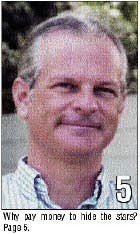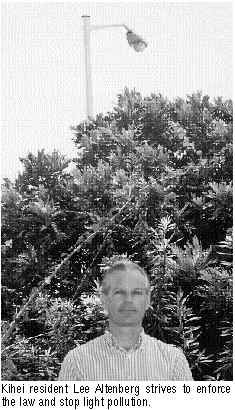
Return to
Front Page
|
|
Save electricity, save tax money and save our
night sky from light pollution. Maui residents push for stronger laws
to control light pollution.
Gene Thompson
Not long ago the night sky, replete with planets,
stars and the Milky Way, was a glory to behold. Little by little, however,
brilliant night skies have become visible only in remote areas.
The culprit is not air pollution but inefficient
lighting sources that light up the sky needlessly, says a University
of Hawaii scientist.
Yet, where a little thought and caring are part
of the planning equation, light pollution can be reduced. In fact, there
is an effort afoot to make sure we can see the night skies.
What can be done to reclaim our night skies? A
great deal, according to Kihei resident Lee Altenberg Ph.D., an expert
on light pollution and an activist working for its reduction. In an
interview with the Maui Weekly, Altenberg, a scientist in the field
of population biology for the University of Hawaii, said that a number
of US cities—Tucson, Flagstaff, Kennebunkport, Maine, River-side, Ca.
and others—have taken steps to reduce light pollution. It is also an
issue in many foreign countries, especially where observatories exist.
The lighting system used at Wailea also seems
to work well. The Wailea system uses anodized aluminum light standards
that blend in with the trees and landscape. The same kind of lighting
was installed on the Lipoa Parkway and the Kihei Community Center. The
result is a softer, less intrusive light that still provides ample illumination.
The light is directed downwards, so that it does not light up the surroundings.
Contrasting with this friendlier lighting is the
``cobra'' style lights used along the recently developed areas of the
Piilani Highway. Harder to understand is the forest of glaring cobras
mounted on intrusive aluminum standards along Makena Alanui.
The Big Island, Altenberg said, has an ordinance
requiring low pressure sodium (LPS) lights which give off a yellow light.
However, the LPS lights in Hilo were installed without shields, which
means that the light still goes sideways and up, lighting the surroundings
and the sky.
``It helped with the telescopes that are much less
affected by LPS light but they are not ideal,'' Alternberg said.
``A lot of energy goes into lighting up the sky,''
said Altenberg. ``It’s just mindless. If it weren’t for light pollution
from Kahului to Kihei you could see the whole Milky Way. The cause of
light pollution is not greed. Its not anybody’s intent to light up the
sky.''
``My impulse is to let somebody know they are doing
it wrong,'' he added.
|
|
In 1997, he wrote to members of the County Council
about the problem. He found the council receptive.
``In 1999, I found with proper conservation you
could reduce wattage use by 30 percent and still have the same amount
of light on the ground.'' He also found that retrofitting Maui street
lights would have a three- to five-year payback time.
``If in 1999, the retrofit had been started, we
would be earning money from the electricity we would be saving,'' he
said.
He also noted that the Kalama Park playing field
has an ``overkill'' of light.
``There is a company that sells fully shielded
lights for athletic fields,'' he said. ``We could change the lights and
the problem would be gone.''
Altenberg figured his efforts paid off in October
1999 when the Maui County Council voted an ordinance requiring fully
shielded street lights, effective March last year. After five years
all street lights would have to conform.
``But the new lights on Piilani Highway are all
unshielded,'' he said. ``They are putting them in left and right in Kihei
and all the way to Makena. What do you do when people continually ignore
the law?'' he asked.
His question will come up on August 15, when the
topic of light pollution will resume by the council’s Public Works and
Transportation Committee. Working as an ad hoc committee with Steve
Sutrov, president of the Kula Community Association and other parties,
he will present an amendment to the current ordinance that includes
enforcement along with education and notification provisions. The amendment
will address all lights, not just street lights.
Mike Maberry, head of the Institute for Astronomy
at the Haleakala observatory, is also a member of the ad hoc committee.
``They have an interest because their instruments
will be rendered useless if the current sprawl of light pollution on
Maui continues,'' Altenberg said.
``We have to get it together and pay attention.
What we are up against is just inertia.''

|